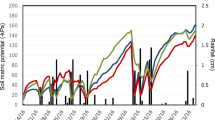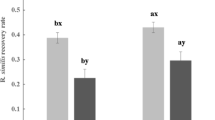Abstract
Vegetable farming systems in tropical and subtropical Australia are vulnerable for several reasons: degradation of the soil resource due to excessive tillage; environmental problems associated with off-site movement of soil, nutrients and pesticides during intense rainfall events; over-reliance on increasingly expensive external inputs (e.g. fossil fuels, plastic film, nutrients and pesticides); and de-registration of the soil fumigants and nematicides normally used to control soilborne pathogens. This two-year experiment compared the performance of a conventional capsicum farming system (an annual forage sorghum rotation crop and normal tillage practices) with three farming systems considered likely to be more sustainable because reduced tillage, a leguminous rotation crop, mulched crop residues and inputs of organic amendments were integrated into the system. One of these alternatives (capsicum grown under minimum tillage in soil mulched with crop residues rather than plastic) yielded significantly less fruit in both years, while root rotting caused by Pythium recalcitrans and Rhizoctonia solani caused problems in all alternative systems in the second year, presumably because the pathogens multiplied on residues from the previous rotation crop. Nevertheless, one of the sustainable alternatives (organic inputs from amendments and direct-drilled rotation crops for 2 years, with plastic laid onto a mulch of crop residues) performed well in all other respects, enhancing suppressiveness to root-knot nematode (Meloidogyne incognita) in the second year and producing higher yields than the conventional system in both years. These results suggest that the conventional vegetable farming system could be improved by 1) incorporating annual applications of commercially-available organic amendments, 2) growing cultivars of forage sorghum and soybean with resistance to root-knot nematode as rotation crops under minimum tillage on permanent beds, 3) mulching biomass from the rotation crops onto the bed surface well before the vegetable crop is to be planted, and 4) leaving the bed undisturbed and covering those residues with plastic. Future research should therefore concentrate on fine-tuning such farming systems; optimising residue management practices to minimise losses from root rotting pathogens that are good competitive saprophytes; and developing mulch-laying equipment capable of laying plastic onto undisturbed beds covered with crop residue.





Similar content being viewed by others
References
Adl SM, Coleman DC, Read F (2006) Slow recovery of soil biodiversity in sandy loam soils of Georgia after 25 years of no-tillage management. Agric Ecosyst Environ 114:323–334
Akhtar M, Malik A (2000) Roles of organic soil amendments and soil organisms in the biological control of plant-parasitic nematodes: a review. Bioresource Technol 74:35–47
Baker CJ, Saxton KE, Ritchie WR, Chamen WCT, Reicosky DC, Ribeiro MFS, Justice SE, Hobbs PR (2006) No-tillage seeding in conservation agriculture, 2nd edn. CAB International/FAO, Oxford
Bridge BJ, Bell MJ (1994) Effect of cropping on the physical fertility of krasnozems. Aust J Soil Res 32:1253–1273
Eckert JW, Tsao PH (1962) A selective antibiotic medium for isolation of Phytophthora and Pythium from plant roots. Phytopathol 52:771–777
Franzluebbers AJ (2004) Tillage and management effects on soil organic matter. In: Magdoff F, Weil RR (eds) Soil organic matter in sustainable agriculture. CRC Press, Boca Raton, pp 227–268
Garside AL, Bell MJ (2001) Fallow legumes in the Australian sugar industry: review of recent research findings and implications for the sugarcane cropping system. Proc Aust Soc Sugar Cane Technol 23:230–235
Garside AL, Bell MJ, Robotham BG, Magarey RC, Stirling GR (2005) Managing yield decline in sugarcane cropping systems. Int Sugar J 107:16–26
Hamblin A (1995) The concept of agricultural sustainability. Adv Plant Pathol 11:1–19
Hobbs PR, Sayre K, Gupta R (2008) The role of conservation agriculture in sustainable agriculture. Phil Trans Royal Soc B 363:543–555
Hochmuth G, Maynard D, Vavrina C, Hanlon E, Simonne E (2009) Plant tissue analysis and interpretation for vegetable crops in Florida. University of Florida IFAS Extension, Publication HS964, 55pp
Kinloch RA (1998) Soybean. In: Barker KR, Pederson GA, Windham GL (eds) Plant and nematode interactions. American Society of Agronomy, Madison, pp 317–333
Lewandowski I, Hardtlein M, Kaltschmitt M (1999) Sustainable crop production: definition and methodological approach for assessing and implementing sustainability. Crop Sci 39:184–193
Lu Y-C, Watkins KB, Teasdale JR, Abdul-Baki AA (2000) Cover crops in sustainable food production. Food Rev Int 16:121–157
Manici LM, Caputo F, Babini V (2004) Effect of green manure on Pythium spp. population and microbial communities in intensive cropping systems. Plant Soil 263:13–142
McSorley R (2001) Multiple cropping systems for nematode management: a review. Soil Crop Sci Soc Fla Proc 60:132–142
McSorley R (2011) Overview of organic amendments for management of plant-parasitic nematodes with case studies from Florida. J Nematol 43:69–81
Moralejo E, Clemente A, Descals, E et al. (2008) Pythium recalcitrans sp. nov. revealed by multigene phyogenteic analysis. Mycologia 100:310–319
Oka Y (2010) Mechanisms of nematode suppression by organic soil amendments—a review. Appl Soil Ecol 44:101–115
Pretty J (2008) Agricultural sustainability: concepts, principles and evidence. Phil Trans Royal Soc B 363:447–465
Robideau GP, de Cock AWAM, Coffey MD et al (2011) DNA barcoding of oomycetes with cytochrome c oxidase subunit I and internal transcribed spacer. Mol Ecol Resour 11:1002–1011. doi:10.1111/j.1755-0998.2011.03041.x
Sánchez-Moreno S, Ferris H (2007) Suppressive service of the soil food web: effects of environmental management. Agric Ecosyst Environ 119:75–87
Stirling GR (1991) Biological control of nematodes: progress, problems and prospects. C.A.B.. International, Wallingford, 284 pp
Stirling GR (2008) The impact of farming systems on soil biology and soilborne diseases: examples from the Australian sugar and vegetable industries- the case for better integration of sugarcane and vegetable production and implications for future research. Aust Plant Pathol 37:1–18
Stirling GR, Eden LM (2008) The impact of organic amendments, mulching and tillage on plant nutrition, Pythium root rot, root-knot nematode and other pests and diseases of capsicum in a subtropical environment, and implications for the development of more sustainable vegetable farming systems. Aust Plant Pathol 37:123–131
Stirling GR, West LM, Fanton JA, Stanton JM (1996) Crops and their resistance to root-knot nematodes (Meloidogyne spp.). Queensland Department of Primary Industries, Information Series QI96085
Stirling GR, Eden LM, Ashley MG (2004) Sudden wilt of capsicum in tropical and subtropical Australia: a severe form of Pythium root rot exacerbated by high soil temperatures. Aust Plant Pathol 33:357–366
Stirling GR, Berthelsen JE, James AT, Agnew JR (2006) The impact of root-knot nematodes (Meloidogyne spp.) on legume crops grown in rotation with sugarcane. Proc Aust Soc Sugar Cane Technol 27:351–358
Stone AG, Scheuerell SJ, Darby HM (2004) Suppression of soilborne diseases in field agricultural systems: organic matter management, cover cropping, and other cultural practices. In: Magdoff F, Weil RR (eds) Soil organic matter in sustainable agriculture. CRC Press, Boca Raton, pp 131–177
Thoden TC, Korthals GW, Termorshuizen AJ (2011) Organic amendments and their influences on plant-parasitic and free-living nematodes: a promising method for nematode management? Nematology 13:133–153
Wardle DA (1995) Impacts of disturbance on detritus food webs in agro-ecosystems of contrasting tillage and weed management practices. Adv Ecol Res 26:105–183
Weil RR, Magdoff F (2004) Significance of soil organic matter to soil quality and health. In: Magdoff F, Weil RR (eds) Soil organic matter in sustainable agriculture. CRC Press, Boca Raton, pp 1–43
White TJ, Bruns T, Lee S, Taylor J (1990) Amplification and direct sequencing of fungal ribosomal RNA Genes for phylogenetics. In: Innis MA, Gelfand DH, Sninsky JJ, White TJ (eds) PCR protocols: a guide to methods and applications. Academic Press, Inc, California, pp 315–322
Whitehead AG, Hemming JR (1965) A comparison of some quantitative methods of extracting small vermiform nematodes from soil. Ann Appl Biol 55:25–38
Zeck WM (1971) A rating scheme for the evaluation of root-knot nematode infestations. Pflanzenschutz-Nachricten Bayer 24:141–144
Acknowledgements
This work was a component of a national nematology project funded by Horticulture Australia Limited. Staff from DAFF at Bundaberg Research Station helped with the field experiment, and their contribution is gratefully acknowledged. Neil Halpin, Gavin Berry and Warren Flor ensured that the trial ran smoothly; Bill Rehbein played a significant role in managing the plots and applying the treatments; Dr. Gunasekhar Nachimuthu provided advice on the fertigation programme, and Sheree Short and Steve Ginns provided valuable assistance at various times. Dr Phil Brown and Sushil Pandey (Central Queensland University) contributed by measuring soil strength and capsicum root distribution patterns after the crop was harvested, while Dr Mike Bell (QAAFI, Kingaroy) and Dr Phil Moody (DERM, Brisbane) made helpful suggestions when the work was being planned. A special thank you to Mr. Duy Le (University of Queensland), who kindly used molecular methods to identify the Pythium isolates as P. recalcitrans.
Author information
Authors and Affiliations
Corresponding author
Rights and permissions
About this article
Cite this article
Stirling, G.R. Integration of organic amendments, crop rotation, residue retention and minimum tillage into a subtropical vegetable farming system enhances suppressiveness to root-knot nematode (Meloidogyne incognita). Australasian Plant Pathol. 42, 625–637 (2013). https://doi.org/10.1007/s13313-013-0236-9
Received:
Accepted:
Published:
Issue Date:
DOI: https://doi.org/10.1007/s13313-013-0236-9




